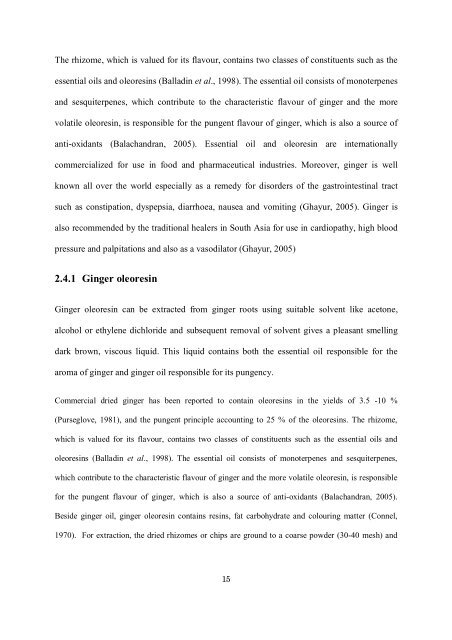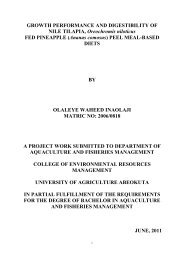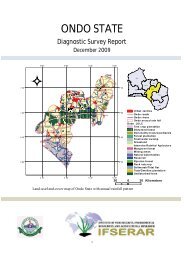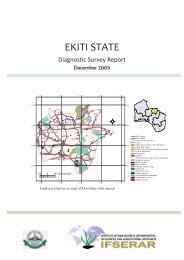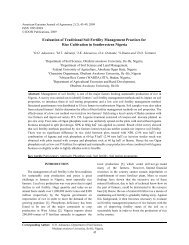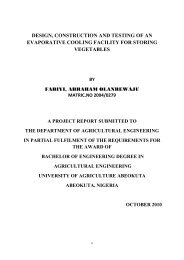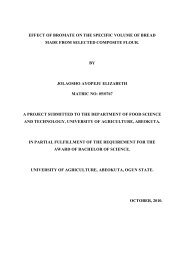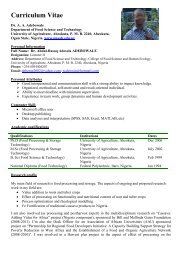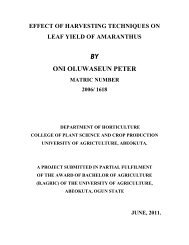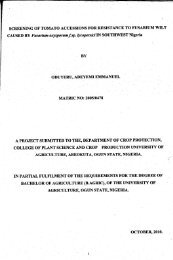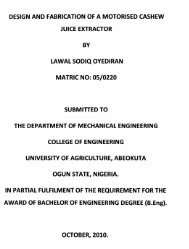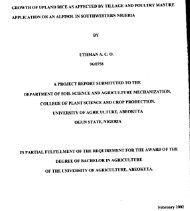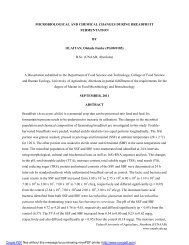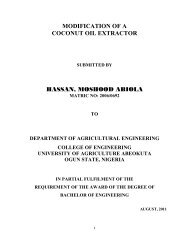consumer acceptability of spiced composite bread - The Federal ...
consumer acceptability of spiced composite bread - The Federal ...
consumer acceptability of spiced composite bread - The Federal ...
Create successful ePaper yourself
Turn your PDF publications into a flip-book with our unique Google optimized e-Paper software.
<strong>The</strong> rhizome, which is valued for its flavour, contains two classes <strong>of</strong> constituents such as the<br />
essential oils and oleoresins (Balladin et al., 1998). <strong>The</strong> essential oil consists <strong>of</strong> monoterpenes<br />
and sesquiterpenes, which contribute to the characteristic flavour <strong>of</strong> ginger and the more<br />
volatile oleoresin, is responsible for the pungent flavour <strong>of</strong> ginger, which is also a source <strong>of</strong><br />
anti-oxidants (Balachandran, 2005). Essential oil and oleoresin are internationally<br />
commercialized for use in food and pharmaceutical industries. Moreover, ginger is well<br />
known all over the world especially as a remedy for disorders <strong>of</strong> the gastrointestinal tract<br />
such as constipation, dyspepsia, diarrhoea, nausea and vomiting (Ghayur, 2005). Ginger is<br />
also recommended by the traditional healers in South Asia for use in cardiopathy, high blood<br />
pressure and palpitations and also as a vasodilator (Ghayur, 2005)<br />
2.4.1 Ginger oleoresin<br />
Ginger oleoresin can be extracted from ginger roots using suitable solvent like acetone,<br />
alcohol or ethylene dichloride and subsequent removal <strong>of</strong> solvent gives a pleasant smelling<br />
dark brown, viscous liquid. This liquid contains both the essential oil responsible for the<br />
aroma <strong>of</strong> ginger and ginger oil responsible for its pungency.<br />
Commercial dried ginger has been reported to contain oleoresins in the yields <strong>of</strong> 3.5 -10 %<br />
(Purseglove, 1981), and the pungent principle accounting to 25 % <strong>of</strong> the oleoresins. <strong>The</strong> rhizome,<br />
which is valued for its flavour, contains two classes <strong>of</strong> constituents such as the essential oils and<br />
oleoresins (Balladin et al., 1998). <strong>The</strong> essential oil consists <strong>of</strong> monoterpenes and sesquiterpenes,<br />
which contribute to the characteristic flavour <strong>of</strong> ginger and the more volatile oleoresin, is responsible<br />
for the pungent flavour <strong>of</strong> ginger, which is also a source <strong>of</strong> anti-oxidants (Balachandran, 2005).<br />
Beside ginger oil, ginger oleoresin contains resins, fat carbohydrate and colouring matter (Connel,<br />
1970). For extraction, the dried rhizomes or chips are ground to a coarse powder (30-40 mesh) and<br />
15


